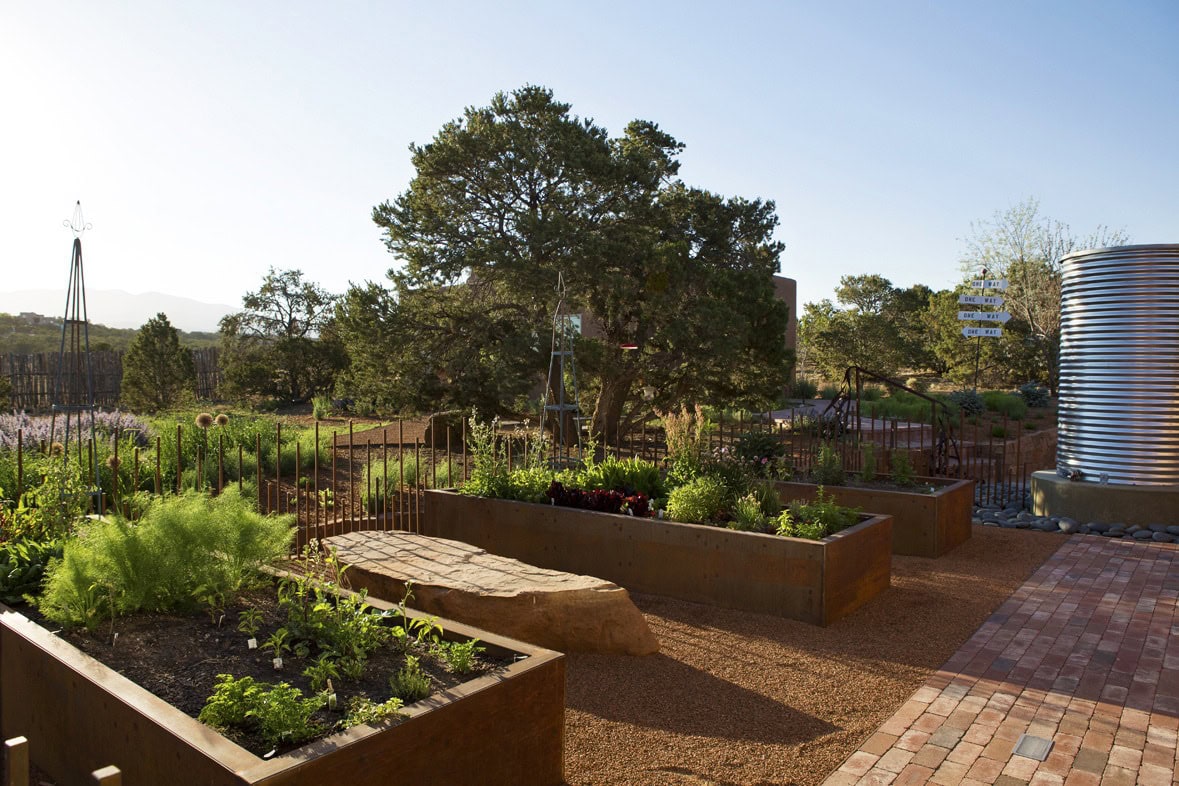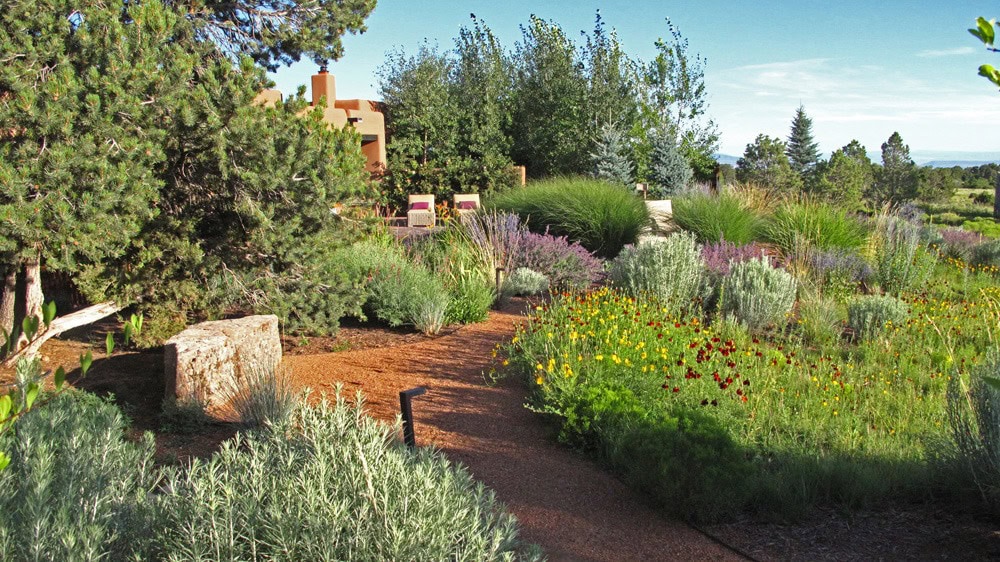Written by Laura Thompson
Landscape Design by Surroundings Studio
Photography by Kate Russell

Santa Fe is a city of superlatives, boasting the oldest state capital (1610), the oldest home (Pueblo, circa 1059) and the highest state capital (7,200 feet)—to name a few. But one of the most striking facts about this Southwestern gem is the number of days of sunlight annually (283) compared to the annual average rainfall (only 14 inches). In comparison with the US annual average of 205 days of sunlight and 39 inches of rainfall, the sun-to-rain ratio in Santa Fe is significantly lower, sharpening the focus on one thing: water.
In the Southwest, landscape design and water are inextricably linked. All projects revolve around a closely examined irrigation plan. Enter the thoughtful, detailed and aqua-conscious landscape design of Surroundings Studio and their Woven Plains project. This innovative and breathtaking landscape design project, completed in 2008, helped to propel Surroundings onto Santa Fe’s—and the nation’s—landscape design map.
The 2.5-acre Woven Plains property, located just outside Santa Fe, offered a myriad of design options. According to Kenneth Francis, principal of Surroundings Studio, several key priorities were identified from the start. Above all, the owners aimed to achieve greater privacy for their home. But to create that privacy—using plant life as a buffer—water was critical.
“Privacy was key, as they are on a fairly flat site surrounded by other homes,” says Francis. “But they loved the open feel of the piñon juniper landscape, so we created a strategy of weathered steel screen walls and evergreen piñon trees that would selectively provide privacy, but still allow the expansive landscape to ‘leak’ beyond the property.”

Adding aspen trees, which only grow in the high desert of Santa Fe under just the right conditions, was another client request, so water catchment was a crucial factor. “Our clients love aspens, and in particular, they love the sound of their leaves blowing in the wind, so we had to address transplanting existing ones and adding more,” recalls Francis. “More importantly, aspens drink more water, so we needed to find creative ways to ‘catch, carry and concentrate’ stormwater to this garden to help it thrive.”

The design approach started with a comprehensive assessment of water sources. Francis, who came to Santa Fe on a fellowship while at Harvard’s School of Design, is a student of acequias—a water catchment system with a history that spans hundreds of years, continents and cultures. Thought to first be used in the ultra-arid Arab world and brought to Spain by the Moors, this technique of gravity-fed irrigation canals was first used in the Southwest in the early 1500s, building upon similar techniques already developed by the Native American Pueblo Tribe.
“In Northern New Mexico, particularly here in Santa Fe, we get only about 11–12 inches of rain per year. Every drop counts,” says Francis. “Our goal was to orchestrate the movement of water to where we needed it most. We found many great sources of stormwater, but we needed to convey most of it to the water-loving aspen area. That was what triggered the idea of a stormwater acequia that carries rainwater to the aspen grove.”
Francis and his team created an acequia network that provides a steady and reliable water source for the property’s aspen trees and the plants added to the home’s landscape. The network pulls water from the rooftops into a cistern, while the stormwater acequia pulls water from the driveway runoff. The water filters into the rock-lined acequia feeding the property’s plant systems. The acequia also serves as a“threshold between the more formal landscape near the house and the looser, more natural landscape beyond.”

Another “must-have” for the homeowners: more entertaining space. A new, larger terrace allows for greater entertaining area, with two different shades of brick used to create “desire lines,” or pathways. Sheep fescue and Reveille sod (a unique turf grass that requires less water than bluegrass) created additional outdoor space.


Carving out space for a vegetable garden was also key. “Cooking and entertaining are very important to the owners, and the wife is an avid—and amazing—cook, so raised vegetable planters were crucial to the design,” says Francis. The team found spaces around the terrace and close to the kitchen to allow for easy maintenance and harvesting of the garden.

The colorful palette selected by the Surroundings team pulls it all together. The new plan included the textural elements of a yucca field, a wildflower meadow, a native grass berm, a blue garden and an oasis garden. The landscape incorporates the soothing blues of English Lavender, purple Alliums, Purple Bearded Iris and Grape Hyacinth, with pops of orange from Orange Daylilies, orange Double Tulips, Deep Red Oriental Poppies, and Burgundy-Leafed Crabapple trees. Surroundings created a “dominantly native palette, with enhanced native grass and wildflower meadows” that enlivened the property’s landscape with flowering plants, grasses and shrubs that meld with the environment.

Punctuating the property’s makeover was the addition of outdoor sculptural works. Steel bands and structures for the tomato vines were incorporated into the raised vegetable beds by local Santa Fe steel and light artist Jody Norskog.
The weaving together of these critical elements—each strand essential to the project’s success—yields a remarkable outcome. While the project’s innovative water system provides underlying support, the layer of glorious aspen trees maintains privacy. Yucca, lavender, lilies, poppies and tulips offer color and texture to enhance the finished product—creating yet another of Santa Fe’s superlatives: Woven Plains.




Leave a Reply